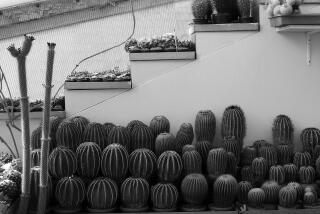The Geometric Secrets of the Cactus
- Share via
It could be said that cactuses are exceptional examples of geometry, the branch of mathematics that focuses on points, lines, planes and figures. They can assume amazing forms, and some are masters of the helix and other complicated mathematical sequences and equations.
Helixes are three-dimensional spirals that are governed by a set of increasing numbers called the Fibonacci series that goes 1, 1, 2, 3, 5, 8, 13, 21 and so on. The sequence was developed back in the Middle Ages by the same mathematician who convinced Europe to accept the Arabic numeral system.
Fibonacci, of course, never saw a cactus or its spirals, because cactuses are native to the New World, which was yet to be discovered. Helixes are found in other natural objects, though, including many seashells and DNA (which is actually a double helix).
In “Cactus Primer” (Harvard University Press; 1985), authors Arthur Gibson and Park Nobel devote an entire chapter to the complicated geometry of cactuses, describing the science behind it. They do not theorize why, but others have--that the spiral arrangement of ribs and the little bumps called tubercles make the plants structurally sound, or that they act like fins for cooling, or allow for seasonal expansion and contraction.
The helixes on cactuses may be obscured or disguised by thorns and bristles, but find one of the nuder cactuses--and many of the smaller ones are quite free of thorns--look down on the arrangement of ribs or tubercles, and you will see the spirals.
You can clearly see this geometry on the cactus inside the greenhouses of the Huntington Botanical Gardens Desert Gardens Conservancy in San Marino. These house some of the smaller kinds that would not survive on the mean streets of the Huntington’s sprawling outdoor collection where bigger, tougher cactuse grow.
Arranged in handsome, earthy pots, the small cactuses are easy to study. And John Trager, the caretaker of these little jewels and the curator of desert collections, points out that cactuses are also “adept at geometrical aberration.”
Collectors will pay top dollar for some of these aberrations, including the so-called “crested”--or fasciated cactuses--with their bizarre, malformed tops. Fasciated cactuses have a cylindrical base that turns into a flattened, fan-like crown of dubious distinction that is nonetheless valued.
Count on some of them being for sale or on display at the Intercity Cactus and Succulent Show this weekend (see the garden events listing). Should you go to the show, be sure to stop, while browsing the sale and show tables, to enjoy the pure geometry.






